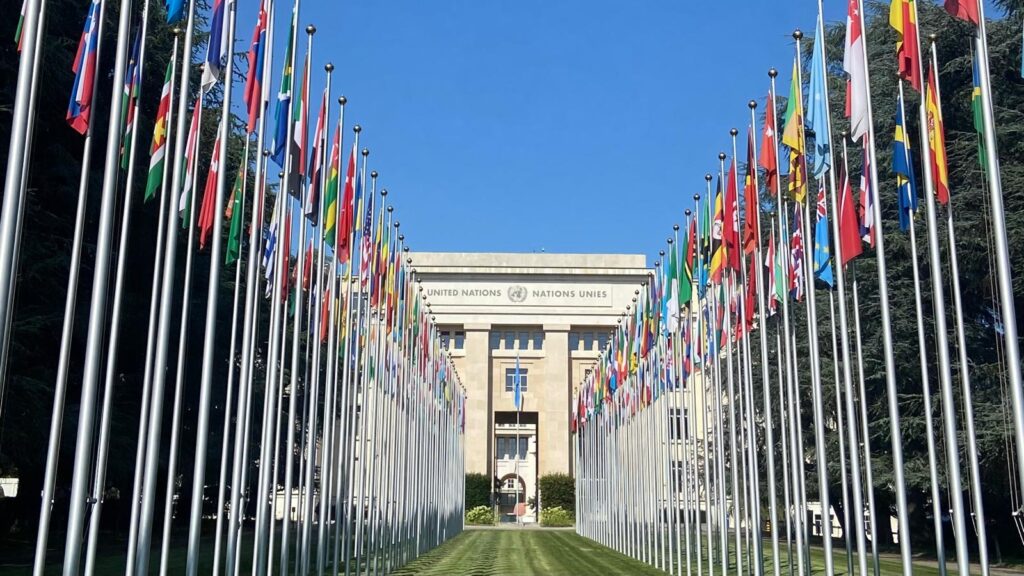GGE/CCW August 2024 Newsletter

For this project, we’ve built a Python algorithm to transform raw transcripts from the CCW/GGE on LAWS into an organized spreadsheet, generating organized csv files for each session of the August GGE.
With the organized spreadsheets we have generated data-driven insights on participation, inclusion, and other aspects of the forum.
As one of the results of this project, the InterAgency Institute has created a Newsletter, which brings daily data-driven insights from the CCW and the data base of the meetings.
Find more about the project here.
Tuesday, August 27th
States framing the CCW as the appropriate forum (10 + 2):
Click on the flags to view the statements!
 ISRAEL
ISRAEL
 FRANCE
FRANCE
 CHINA
CHINA
 DENMARK
DENMARK
 ITALY
ITALY
 SWEDEN
SWEDEN
 BULGARIA
BULGARIA
 UNITED STATES
UNITED STATES
 SINGAPORE
SINGAPORE
 RUSSIAN FEDERATION
RUSSIAN FEDERATION
EXTRA: Would you consider these lines as a way to put the CCW as the appropriate forum?
 PAKISTAN
PAKISTAN
“Pakistan supports developments of a new CCW protocol on laws spelling out prohibitions and regulations to ensure compliance with the IHL and consistency with the objective and purpose of the CCW.”
 JAPAN
JAPAN
“Japan strongly supports the continuation of the discussion under the CCW.”
Context: “Chair, we have a three – year mandate to draft elements of an instrument and have been encouraged to complete our work by 2025. While we made a promising start, your rolling text is a good basis for our consultations this week. We commend you for this effort and for ably steering the work of this GGE. Pakistan supports developments of a new CCW protocol on laws spelling out prohibitions and regulations to ensure compliance with the IHL and consistency with the objective and purpose of the CCW. The humanitarian legal ethical and security dimension must always remain integrated in a meaningful manner in the work of the GGE including the selection of its topics.”
Context: “In international rule making on laws, universality of rules is required for ensuring effectiveness. It is necessary for stakeholders including those with advanced technologies capabilities to participate in these discussions and from this perspective, Japan strongly supports the continuation of the discussion under the CCW. Thank you, Mr. Chairperson.”
Wednesday, August 28th
What delegations say when they use the word “risk” in the GGE
Analysing 25 Statements On “Risk”:
*Click on a delegation’s name to view their statement:*
7 from Civil Society:
FUTURE OF LIFE INSTITUTE
“We should address all risks in a comprehensive manner;”
“Ignoring risks beyond IHL would make us work with a treaty that doesn’t address practical implications of AWS;”
INTERAGENCY INSTITUTE
“Dehumanization risks undermining IHL principles of distinction, proportionality, and precaution;”
STOP KILLER ROBOTS
“Arms race pose risk to international peace and security;”
THE CIVILIAN AGENDA
“UN Special Rapporteur on Racism said AWS pose risk of racial discrimination;”
SEHLAC
“Tech disparity risks widening gap between the global north and south and intensifying the military dependence, widening power gaps incentivized by the proliferation of these weapons;”
ICRC
“SG report warned about risks of AWS;”
“Adding qualifiers to AWS definition risks scope reduction through cumulative conditions;”
1/7 procedural issues, keep this in mind;
18 HCP Statements:
- Ireland and Denmark warned about the risk of bias in gender, ethnicity, age, and disability;
- Venezuela made 2 Statements citing risks in AWS;
- 8/18 statements talked about risks in procedures:
- Pakistan stressed adding functions cumulatively to the ICRC definition will narrow treaty scope (2x);
- Brazil and Argentina pointed loophole potential in the “nominal human input” formulation;
- Israel and Sweden are more worried about the risks of bringing the autonomous weapons to the UNGA;
- Sweden is also worried about the risk of banning “non-lethal autonomous weapons”;
- Fun fact: New Zealand warned us about the risk of “being overwhelmed with footnotes”;
- Poland, Italy, and Japan talked about “risks & benefits” of AWS;
- G15 and South Africa pointed “inherent risks” in AWS;
- G15 stressed anything short of a comprehensive approach to AWS regulations are a disservice to our common task of protecting humanity;
- South Africa said lack of regulations “undermining civilian protection”;
Are You Team AWS or LAWS?
The debate if the word “lethal” on LAWS should be kept
Background: Somes States are pushing for the removal of the word “Lethal” in LAWS. During this afternoon the Chair tried to incorporate this by adding a footnote to the revised text. The footnote reads as follows:
“For the purposes of the working characterization of LAWS, the term “Lethal” is understood as the capability of a weapon system to inflict death, injury, destruction or damage to persons or objects.”
Findings:
- On Monday only 42 of the 81 statements used the word “Lethal”;
- Main arguments for taking it out:
- Ireland, Pakistan, Peru, New Zealand, Panama and Brazil stressed injury can also be an IHL violation;
- G15, Switzerland, Costa Rica, Pakistan, and Peru stressed lethality is an effect;
- Ireland and Pakistan said “Lethal” has no IHL basis;
- 3x more HCP have explicitly supported keeping than removing it in this August session:
Team LAWS [8]
Team AWS [24]
| Argentina | G15 (G16 – Argentina) |
| Israel | Switzerland |
| Singapore | Ireland |
| Guatemala | Pakistan |
| China | Austria |
| India | Brazil |
| Venezuela | New Zealand |
| Italy | Panama |
| Norway |
- On the footnote:
- Norway, Panama, Costa Rica, Brazil, Switzerland and El Salvador want to keep “objects” in the definition, and India wants to remove it.
- U.S. and Russian Federation suggested new language for the footnote;
- U.S.:
- change “or” for “and”;
- Add in the end: as part of an attack;
- Supported by ROK;
- RU:
- Add: capability of carrying out the goals , that is , creating specific conditions for those objectives to be carried out.
- Take into account non-kinetic impact;
- U.S.:
- Switzerland, Canada, and New Zealand want to contextualize this definition is for this GGE;
- France and ROK said defining “lethal” is unnecessary, while Brazil supported the definition because the word serves two purposes:
- Saying only military applications will be regulated/restricted;
- Not regulating all military AWS;
- Italy suggesting incorporating to the definition IHL violations that doesn’t involve killing;
Thursday, August 29th
On International Humanitarian Law
What are delegations saying about the Martens Clause?
Methodology: We’ve selected all statements that say “IHL” or “Humanitarian” and selected those who talked about the Martens Clause and its applicability to LAWS. This is what HCP are saying about the Martens Clause and AWS:
Findings:
AUSTRIA
“We would like to also include one aspect that is in the preambular part of the CCW which reads basing themselves on the principle of international law that the right of the parties to an armed conflict to choose methods or means of warfare is not unlimited and on the principle that prohibits the employment in armed conflicts of weapons, projects and material methods of warfare of a nature to cause oh, no, sorry. Wrong para. Sorry. I was just looking for methods or means of warfare. So the right one is recalling that it is prohibited to imply okay, basically it is the Martens clause from the preambular part.”
U.S
“So I want to read out a specific text proposal just to give people an idea. We can also send it to the Chair as I know it is hard for people to sort of take down long text proposals. But I will read it out now. It would say:
‘the purpose of this instrument is to clarify how principles of IHL which are derived from established custom from the principles of humanity and from the dictates of public conscience remain applicable and impose requirements that protect the civilian population and combatants and to specify prohibitions and other regulatory measures for states to effectively satisfy these IHL requirements in armed conflict and help effectuate human intentions to comply with IHL and to avoid harm to civilians and civilian objects.’
We think this language is really helpful in again as I said providing general orientation and direction and in particular we think it is useful to draw on the Martens clause which is a really important concept in addressing new technologies in warfare and the group has found consensus on it in the past.
And then we also think this purpose language is useful to address the core challenge of autonomy which we talk about a lot here which is ensuring that machines effectuate the intention of their human users and in the context of the CCW in particular the intention of human beings to comply with IHL and reduce the risk of harm to civilians and civilian objects. So we can send that to you, Chair but wanted to sort of put the idea out for consideration on the floor. Thank you.”
RUSSIAN FEDERATION
“We note that there are no grounds for stating that the principle of humanity in itself or the requirements of public recognition, public awareness, for example, under the Martens clause or the human component, the human rights component may be considered as an absolute and a unique adequate condition for the introduction of prohibition or restriction regimes as regards a particular type of weapon.
The Martens clause because of its nature can be used only to assess the human behavior during military action, including decision making, in programming and applying the relevant weapons, but not the actions of the weapons themselves requiring that a machine comply with the principle of humanity and public awareness is impossible. We affirm once more that in line with international law, responsibility for decisions to create and apply lethal autonomous weapon systems at all stages of their life cycle is born by states and by individuals including the developers, the manufacturers, those who use the weapon systems with autonomous functions.
This approach applies to all types of weapons and means of conducting military activity. So grounds for preventive prohibition on lethal autonomous weapon systems on the basis of moral postulates can bring an unnecessary fragmentation of the existing international legal regulation and unavoidable artificial division of weapons into good and bad.”
AUSTRIA
“On the other issues we also want to support the US proposal which we already have outlined to some extent to include the second part of the preambular para that we have in the CCW which quotes Martens clause. I think it is important that we have this as part of a principle or also in relation to IHL, whatever title we decide to use for this section because it is one of the principles that should guide our work here and this is also related to the call for ethical issues and ethical considerations that have been part of our work in the CCW since the very beginning and there’s a call that many Delegations here in this room share.
There has been made this argument that machines cannot apply the Martens clause. There is, I mean, the fix to this is our work here. We have to find out how this would apply but also here the US has made already a proposal by linking it or adding a formulation on the intention, the human intention and that it is linked to the consequences.”
Three Magic Words: Legally Binding Instrument
What are States saying about a legally binding instrument?
Methodology: We’ve selected the Statements that use the words “legally binding instrument” and selected the phrases in these interventions that addressed their positions on that;
Findings:
- 15 HCP + G15 (Colombia, Costa Rica, Chile, the Dominican Republic, Ecuador, El Salvador, Guatemala, Kazakhstan, Panama, Palestine, Peru, Philippines, Uruguay, and Sierra Leone) have called for a legally binding instrument:
VENEZUELA
“Thank you very much, Chairman. The Republic of Venezuela continues to support the strengthening of a clear mandate of the GGE towards developing a legally binding instrument which regulates laws ensuring its conformity with international humanitarian law and international human rights law.”
“Venezuela believes that these prohibitions and regulations must be established in legally binding instruments in the form of an additional protocol to the Convention.”
“Therefore, Venezuela will continue the strengthening of a clear mandate for the group as we move to the development of a legally binding instrument that regulates laws, ensuring their compliance with IHL and international human rights law.”
SRI LANKA
“Sri Lanka remains committed, convinced that normative and nonbinding frameworks are not adequate in addressing the severity of challenges associated with laws.”
“Sri Lanka supports the UN Secretary General’s call in his new agenda for peace for a new legally binding instrument to address these extensive challenges.”
SOUTH AFRICA
“Chairperson, the protection of civilians must be at the center of our considerations. In this context, South Africa strongly believes that the use of laws not regulated by an internationally legally binding instrument introduces a significant increase in risk to those affected by armed conflict by undermining civilian protection, challenging the rule of law and raising concerns under the principles of humanity.”
“Chairperson, South Africa is mindful that the absence of a verification mechanism may pose a challenge to the establishment of prohibitions and restrictions on the development and use of laws. However, these challenges should not prevent the development of a legally binding instrument that will regulate laws.”
“Without advocating for a rush process, South Africa would like to caution against an indefinite lengthy deliberation process while the development and use of lethal autonomous weapons systems is gaining momentum.”
G15
“15 countries that jointly advocate for a legally binding instrument and regulate to prohibit and regulate weapons and autonomous weapons systems.”
“As we start our work for this second session of 2024, it is worth remembering that we are less than a year and four months away from 2026, the time frame established jointly by the UN Secretary General and the ICRC President to start negotiations on a legally binding instrument for the prohibition and regulation of autonomous weapons systems. This same time frame was reiterated in the latest UN Secretary General report published three weeks ago.”
PERU
“We were one of the Latin American countries that supported the Chair’s summarizing from the successful conference in Vienna and also made comments to the report of the Secretary General reiterating our position in favor of the urgent need to agree a legally binding instrument on laws. My country reiterates the call to overcome differences and make progress towards the adoption of a legally binding instrument.”
PAKISTAN
“Each day without a legally binding instrument brings us closer to a future where laws become the norm, a future where machine not human judgment determines the nature of warfare.”
NORWAY
“Norway supports the development of a legally binding instrument in order to clarify the application of international humanitarian law to autonomous weapons systems.”
HOLY SEE
“For the Holy See, given the pace of technological advancements and the research on weaponization of AI, it is of the utmost urgency to deliver concrete results in the form of a solid legally binding instrument and in the meantime to establish an immediate moratorium on their development and use.”
GERMANY
“Germany fully supports the UNSG as the United Secret Generals call upon high contracting parties to fulfill the GGE’s mandate as soon as possible.”
“Report demonstrates that a broad convergence has emerged on the basis of the two – tier approach as had become more and more obvious in previous meetings of this group as well.”
“This approach offers the opportunity to consent [to] a legally binding provision of lethal autonomous weapons systems that operate outside human control in the form of an additional protocol to the Convention on Certain Conventional Weapons on the one hand and to regulate weapon systems with autonomous functions on the other hand.”
“We will continue to engage in this regard and work towards a tangible outcome of the GGE in fulfillment of its mandate to formulate a set of elements of an instrument.”
“We fully support the Secretary General’s call to consent a legally binding instrument by 2026. Germany will continue working towards this goal in the framework of the GGE because this is important to us also in the light of another significant finding of the UN Secretary General’s report on laws.”
COSTA RICA
“On provisions and regulations, Costa Rica is in favor for legally binding instruments that bands antipersonnel autonomous weapons that operate without human control accompanying regulations that limit the use of such weapons systems in line with IHL and other legal international frameworks limiting the scope and objectives in order to guarantee that such systems are only deployed within the objectives that are designated as military by nature.”
BRAZIL
“The recently released report of the SG pursuant to Resolution 78/241 provides ample evidence of the overwhelming support for the regulation of AWS through the negotiation of a legally binding instrument.”
“We commend your efforts and those of your team in the preparation of the rolling text. It is our hope that it will take us closer to the commencement of negotiations on a legally binding instrument on AWS.”
AUSTRIA
“In our view only a legally binding instrument can address the multitude of challenges autonomous weapons systems pose and the overwhelming majority of states is sharing this view. We hope to convince those who still hesitate and believe that our work here today is contributing to this goal.”
“On the positive side we are seeing strong momentum and interest by the international community to address this issue. The support for legally binding instrument on AWS is not only predominant but growing. The Vienna conference, humanity at the crossroads at the end of April has seen the participation of 144 states and over 1,000 Delegates from academia, industry and civil society. 35 states have joined the Chair’s summary and its content and we want to use this opportunity to thank them.”
- Other 4 States have used “legally binding instrument in their Statement, without explicitly calling for one:
SINGAPORE
“We appreciate that the current mandate of the group focuses on elements of an instrument without prejudging its nature. This enables us to focus on substantive questions, recognizing that norms and legally binding instruments are complementary and not mutually exclusive. We hope progress can be made in defining pathways to preserve the human element in the use of force.”
IRELAND
“We also welcome the further clarification of the weapons that we are not discussing here and which are appropriately addressed under other relevant legally binding instruments. We take into account the comments just made by the US Delegation. Overall, the working characterization is a valuable starting point for negotiations, but we reiterate that further common understandings or specific definitions can and should be discussed under the negotiation mandate. Thank you, Chair.”
FRANCE
“[…] we believe at this stage it is not useful to define lethality. That from the start has been part of the mandate of the GGE. At this time, we believe this would open the way to new debates on the characterization of this topic, which we believe is not something that should be discussed now. It could be done once we have a legally binding instrument to discuss, but at this stage for the conduct of our work, it is not needed.”
COLOMBIA
“My Delegation echoes the words of, in particular, Pakistan regarding the addition of ‘as part of an attack’ [in the definition of lethality]. We see inclusion of this as undesirable. We find it problematic because adding an additional condition to this characterization, as we see it, does not depend on whether the lethal autonomous weapons system is being used or not or a legally binding instrument to apply to it which would set out regulations and prohibitions.”
Friday, August 30th
AWS 2-Tier tIER
What are States saying about the 2-tier approach?
Methodology: We’ve selected the Statements that use the words “legally binding instrument” and selected the phrases in these interventions that addressed their positions on that.
We created a tier system to rank interventions on the 2 tier approach:
- S-Tier:
- Calls for prohibition on anti personnel weapons, weapons that can’t be used with meaningful human control (or similar idea), and weapons noncompliant with IHL;
- A-Tier:
- Calls for prohibition on 3-key points, but with diluted language;
- B-Tier:
- Calls for prohibition on 2 of the 3-key points, with weaker language on meaningful human control;
SWITZERLAND
2024-08-26: “At the same time, we think that you have chosen a wise approach which is to focus at this stage on some key issues, notably on the characterization, the application of IHL and most importantly to get us closer to a shared understanding on prohibitions and restrictions in line with the two – tier approach. We think this focus currently is really useful. Now, on the characterization, we welcome this focus as I said. It is really timely and important to make progress this week. It paves the way for greater common understandings and sharpens our conceptual work and it can help us identify hopefully the elements for a future instrument based on the two – tier approach. One important point here, and I think that also relates to your introductory remarks, we would note that characterization is closely interlinked with other elements addressed in the rolling text and this applies in particular to the elements of prohibitions and restrictions and we will have to make sure that these different aspects make a coherent whole. So we cannot just go through this sequentially but we will have to keep in mind the overall text.”
“A number of Delegations have already talked about the inclusion of nominal human input. We think it is an important point to discuss and we congratulate you for having put it in here in this text, a text which overall is very focused on realistic. So we really like to have the opportunity to discuss this and in our view it really reflects that the human’s role must go beyond the purely nominal input. It must have a certain quality, a quality that allows really some meaningful judgment, meaningful control, whatever we call it. It is not clear to us whether the characterization is the optimal place to put this notion of nominal input. It could also be elsewhere in prohibitions and restrictions and regulations part, but that remains to be seen. I am glad you kicked off this discussion also.”
“On the part where we exclude remote controlled munitions mines and unexploded, for us that is fine. The fact that characterization does not apply to autonomous systems that are not weapon systems makes total sense in that there may also be a need for regulation for those systems, not weapon systems in the future and probably the standards that would apply to such systems are very different to what we want to see with weapon systems. So it is good if we separate this and we would also agree that mines as commonly understood and defined, for instance, in the CCWAP2 would not be covered by this characterization. We should, however, make sure that we do not exclude mines that would be autonomous in their functioning such as autonomous sea mines or so.”
2024-08-28: “For the first paragraph on control, we would propose to add the word ‘human’ before ‘control.’ We do not want to open a loophole for some AI – driven control by a machine. Position here is key. We think it is justified to insert the word ‘human’ here in these preliminary considerations despite the broadly shared understanding that the human does not have to be present at all stages of an autonomous weapon used for compliance with international law, including IHL. We know this can vary depending on the operational context and also depending on other tier 2 restrictions placed on the weapons. But human control has to be present at some key stages. The actual decision to deploy an autonomous weapon system and the assessments and decisions regarding its use in a specific attack remain eminently critical touch points. And human control must be present when implementing and imposing the restrictions. Accordingly, it would be necessary and useful to reference the human role in this first paragraph. On the second paragraph on judgment, I can be very short. We find it good and we should retain it as it is.”
2024-08-28: “We are working in our view towards a two – tier approach instrument on autonomous weapons systems, but with such an inclusion, we might give the impression that we want to go beyond weapons systems like AI decision support systems and we see a certain contradiction when at the same time we are focusing on select and engage. It also raises the question how we would define then the support that might open the door for additional complications.”
AUSTRIA
2024-08-28: “Thank you very much. We are also happy that we are going now into the elements part of our discussion. Maybe a first comment, a general one that did not fit in our three – minute statement but if you are looking into the floor we are seeing that there is a widespread constructiveness with the different groups that we are seeing. We are seeing one group consolidating and growing. We are having proposals from a group of 15 states. We are having different working papers that are all going in a very constructive and very substantial manner which should all also be considered when we go into formulating a set of elements for an instrument. I think this is a large part of the room that is in favor of having something that goes in the direction of a two – tier approach or a provision and regulation. We are looking forward to include all these kinds of proposals also into this text. Having said this, there is a little bit of a problem where we actually discuss the control element. We would be fine with having it as a preliminary consideration because it is such a crucial element but it definitely also has to have a more detailed part in the prohibitions and also in the control in the regulations part. So just to flag that where and how to balance the different the control, the human control aspect in the different parts of the text is something we have to look in a more comprehensive manner. The other thing that we also saw in the guiding principle actually is already we should consider factors such as operational context and system capabilities. Here again this is something that has more to do with control but we have to put it somewhere. It could also be in the preliminary considerations and then just one last proposal that we think could have some value that we would put to the scrutiny of other Delegations. We would like to also include one aspect that is in the preambular part of the CCW which reads basing themselves on the principle of international law that the right of the parties to an armed conflict to choose methods or means of warfare is not unlimited and on the principle that prohibits the employment in armed conflicts of weapons, projects and material methods of warfare of a nature to cause oh, no, sorry. Wrong para. Sorry. I was just looking for methods or means of warfare. So the right one is recalling that it is prohibited to imply okay, basically it is the Martin’s clause from the preambular part.”
UK
2024-08-26: “Mr. Chair, we note that the Delegations in this room vary in view as to the scope of the prohibitions that should be included here and whether we are able to form consensus around wider prohibitions including those that might cover issues such as targeting of persons. However, the UK is of the view that we can find consensus on the text addressing the prohibitions of systems which are by their nature incapable of use in accordance with IHL.”
“So the UK would suggest something along the lines of laws that cannot be used in compliance with IHL, including the principles and requirements of distinction, proportionality and precautions and attack are prohibited.”
“We would therefore propose text which would adopt what was previously misplaced language that we saw in the characterization section which would read the operation of laws without context appropriate human involvement and human judgment is prohibited.”
2024-08-26: “So turning to the first paragraph, it is not clear to us how the without prejudice text wording is designed to operate in respect to the subsequent wording that contains the characterization. The UK would hope that its inclusion is intended to address the points that I have just made on characterization and the two – tier approach on prohibition and regulation. Consequently, we believe that it would be useful to include a chapeau to any agreed language on characterization which notes that the purpose of the characterization is to simply outline the type of system that the GGE’s final agreed set of measures are designed to apply to.”
- C-Tier:
- Just mentions the 2 tier approach without specific areas of prohibition;
ITALY
2024-08-26: “Italy is fully committed to advancing their discussion on the development of elements of a future instrument that according to the two – tier approach should set clear prohibitions and regulations.”
Given their working paper and statements in previous sessions, we know their position is actually compatible with the F-Tier.
FINLAND
2024-08-27: “Finland warmly welcomes the interactive rolling text approach as well as the two – tier principle to which we have some comments later on.”
F-Tier:
- Calls for prohibition on weapons noncompliant with IHL; Could otherwise be substituted by “IHL still applies”;
POLAND
2024-08-26: “A two – tier approach should reflect the fundamental distinction in existing IHL between weapons, the use of which is prohibited by their nature in any circumstances and rules governing the use of other weapons with autonomous functions which are not per se illegal by their nature.”
SINGAPORE
2024-08-26: “Most recently, in 2023, the group agreed on the two – tier approach constituting the prohibition of laws that cannot be used in compliance with IHL and the regulation of other types of laws through limits on types of targets, duration, geographical scope and scale of operations.”
BULGARIA
2024-08-26: “Bulgaria will continue its proactive and constructive work within the GG laws in an effort to promote the convergence on a two – tier approach on the basis of prohibitions and regulations as we consider such an approach to offer a legitimate and favorable framework to address related challenges and concerns autonomous weapons systems raise from humanitarian, legal, security and technological and ethical perspective. In March, Bulgaria joined France, Germany, Denmark, Italy, Luxembourg and Norway in submitting a working paper seeking to consolidate the GG work as the paper allows to structure elements of an instrument based on the two – tier approach. Clarifying the content of the two – tier approach in existing humanitarian law and international law and its application to autonomous weapons systems within an instrument is a condition for effective regulation. Mr. Chairman, Bulgaria is committed to undertake every effort to facilitate the work of the GG laws in advancing the deliberations on the regulation of autonomous weapons systems and fulfilling its mandate to further consider and formulate by consensus a set of elements of an instrument. Regarding the form of an instrument on laws, Bulgaria stands ready to support start of negotiations and adoption of an additional protocol to the CCW on the basis of the two – tier approach by 2026.”
SWEDEN
2024-08-26: “Sweden continues to support the two – tier approach, meaning that the distinction should be made between those autonomous weapons systems that cannot be used in accordance with international law, in particular IHL, and autonomous weapons systems which should be regulated in order to ensure compliance with IHL and other applicable international law. We are pleased to see that the approach has gained traction among state parties and is also reflected in your rolling text proposal. As mentioned in your rolling text, international law including IHL is applicable in all cases, including when it comes to laws. Therefore, we do not agree with the notion that laws exist in an unregulated vacuum.”
DENMARK
2024-08-26: “Denmark supports the two – tier approach indicating that a distinction should be made between those weapons systems that cannot be used in accordance with international law and those systems that includes autonomous features the use of which should be appropriately regulated in order to ensure compliance with international law. Furthermore, we are pleased to see that the two – tier approach is included in the Chair’s proposal for a rolling text. For a full account of our perspectives, we refer to the working paper submitted by Bulgaria, Denmark, France, Germany, Italy, Luxembourg and Norway for the previous session in March.”
NORWAY
2024-08-26: “Norway also continues to strongly believe in usefulness of the two – tier approach. For a fuller statement of Norway’s substantive views, I would refer to our submission to the report of the Secretary General pursuant to Resolution 78/241 on lethal autonomous weapons systems as well as the working paper submitted by Bulgaria, Denmark, France, Germany, Italy, Luxembourg and Norway to the previous session of the GGE. It is quite clear to Norway that international law and in particular international humanitarian law already prescribes limits on the employment and development of autonomous weapons systems. One central effort of this GGE should therefore be to clarify those limits through recommendations for an instrument. That is why we hold that the recommendations of this GGE should be apt for inclusion in a binding instrument. As our Deputy Minister said at the Vienna Conference on autonomous weapons in April, a prohibition must be binding if it is to be meaningful.”
Caveat: To release this briefing timely, we are only covering interventions that explicitly have the word “tier” in the transcripts.
130 interventions had one of the key-words transcribe, only 14 with “tier”;
- Despite no Statements with the word “tier” making it into the A or S-Tier (for lack of addressing the anti personnel weapons problem) 4 Statements talked about anti personnel weapons:
ARTICLE 36
“Antipersonnel autonomous weapon systems should be prohibited.”
COSTA RICA
“On provisions and regulations, Costa Rica is in favor for legally binding instruments that bands antipersonnel autonomous weapons that operate without human control accompanying regulations that limit the use of such weapons systems in line with IHL and other legal international frameworks limiting the scope and objectives in order to guarantee that such systems are only deployed within the objectives that are designated as military by nature.”
AUSTRALIA
“Third, we think the exclusion of mines is appropriate. In our view, mines could be considered a rudimentary form of autonomous weapons, but we do not think they are the focus of our discussions in this GGE. For Australia, mines are regulated by the antipersonnel land mine convention and by CCW protocol 2 as well as general IHL.”
ICRC
“We think that while it may be possible in theory to define restrictions on the use of autonomous weapon systems against humans, for example, some of the restrictions on geographical scope and duration and so on listed in the following paragraphs, it is possible to define such restrictions that would reduce the risk of IHL violations to an acceptable level but we really think that these would be too complicated to be applied reliably and effectively in a wide variety of actual combat situations and that therefore as we have proposed in years gone by for antipersonnel land mines and cluster munitions really the only safe and effective way to ensure that the use of these weapons does not violate IHL is for a complete prohibition. So we would propose the insertion of an additional paragraph on the prohibitions part that would read as follows and we have submitted this in writing to your team, Mr. Chair. I begin. Laws that are designed or used in such a manner to be triggered by the presence, proximity or contact of one or more persons or the target profile of which otherwise represent one or more persons are prohibited. Moving on now to the restrictions below, again in the first restriction ensure that laws operate with appropriate control and human judgment, we again would suggest replacing appropriate with human. Secondly, as we have proposed for antipersonnel autonomous weapon systems we think that and for similar reasons we would like to limit the types of target that the system can engage to military objectives by nature. We consider again that in realistic combat situations autonomous weapon systems which target military objectives other than military objectives by nature, for example, military objectives by location, purpose or use, in those cases the risk of IHL violations will be unacceptably high even with the listed restrictions on duration and geographical scope and so on.”